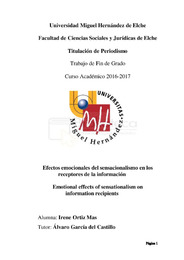Por favor, use este identificador para citar o enlazar este ítem:
https://hdl.handle.net/11000/6511Registro completo de metadatos
| Campo DC | Valor | Lengua/Idioma |
|---|---|---|
| dc.contributor.advisor | García del Castillo López, Álvaro | - |
| dc.contributor.author | Ortiz Mas, Irene | - |
| dc.contributor.other | Departamentos de la UMH::Ciencias Sociales y Humanas | es |
| dc.date.accessioned | 2020-10-15T17:36:16Z | - |
| dc.date.available | 2020-10-15T17:36:16Z | - |
| dc.date.created | 2017-06 | - |
| dc.date.issued | 2020-10-15 | - |
| dc.identifier.uri | http://hdl.handle.net/11000/6511 | - |
| dc.description.abstract | Los medios de comunicación de la actualidad se adentran más que nunca en la tendencia que busca, precisamente, causar impacto y sensaciones en los lectores, oyentes y espectadores. El sensacionalismo ha evolucionado desde su nacimiento bajo la denominación, impuesta por Pulitzer y Hearst, de “Yellow Kid”, hasta convertirse en un recurso infalible para muchas empresas cuya finalidad es captar cuanta más audiencia mejor. ¿Es realmente espectáculo y morbo lo que quieren los receptores de la información? ¿Son capaces de detectar el sensacionalismo? ¿Qué tipo de emociones provoca esta tendencia en las personas? Y ¿en qué medida? ¿Afecta a variables como la credibilidad de la información? Conocer los efectos que surgen según se presenten las noticias sobre los consumidores es el foco principal de este trabajo. Con el objetivo de resolver estas cuestiones, la presente investigación pretende definir a la perfección el concepto de sensacionalismo, explicando su evolución y sus características, y exponiendo algunos claros ejemplos que se han podido ver en los medios de prensa españoles. Además, el estudio realiza un análisis, mediante una encuesta, de los efectos emocionales que tiene dicha tendencia sobre los receptores. Esta pesquisa servirá también para considerar las consecuencias del sensacionalismo sobre la percepción de los receptores en cuanto a credibilidad, seriedad y valor informativo. | es |
| dc.description.abstract | The media today are more than ever in the trend that seeks, precisely, to cause impact and sensations in readers, listeners and spectators. Sensationalism has evolved from its birth under the label, imposed by Pulitzer and Hearst, "Yellow Kid", to become an infallible resource for many companies whose purpose is to capture the most audience better. Is it really spectacle and morbid what the recipients want from the information? Are they able to detect sensationalism? What kind of emotions does this tendency cause in people? And to what extent? Does it affect variables such as credibility of information? Knowing the effects that arise as the news about consumers is presented is the main focus of this work. With the aim to solve these questions, the present investigation tries to define to the perfection the concept of sensationalism, explaining his evolution and his characteristics, and exposing some clear examples that they could have seen in the Spanish means of press. In addition, the study realizes an analysis, by means of a survey, of the emotional effects that the above mentioned trend has on the recipients. This inquiry will serve also to consider the consequences of the sensationalism on the perception of the recipients as for credibility, seriousness and informative value. | es |
| dc.format | application/pdf | es |
| dc.format.extent | 58 | es |
| dc.language.iso | spa | es |
| dc.rights | info:eu-repo/semantics/openAccess | es |
| dc.subject | sensacionalismo | es |
| dc.subject | sensationalism | es |
| dc.subject | morbo | es |
| dc.subject | espectáculo | es |
| dc.subject | emociones | es |
| dc.subject | periodismo | es |
| dc.subject | morbid | es |
| dc.subject | spectacle | es |
| dc.subject | emotions | es |
| dc.subject | journalism | es |
| dc.subject.other | CDU::0 - Generalidades.::070 - Periódicos. Prensa. Periodismo. Ciencias de la información | es |
| dc.title | Efectos emocionales del sensacionalismo en los receptores de la información | es |
| dc.title.alternative | Emotional effects of sensationalism on information recipients | es |
| dc.type | info:eu-repo/semantics/bachelorThesis | es |

Ver/Abrir:
TFG_ORTIZ_MAS_IRENE.pdf
4,33 MB
Adobe PDF
Compartir:
 La licencia se describe como: Atribución-NonComercial-NoDerivada 4.0 Internacional.
La licencia se describe como: Atribución-NonComercial-NoDerivada 4.0 Internacional.
.png)